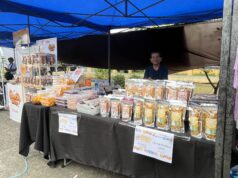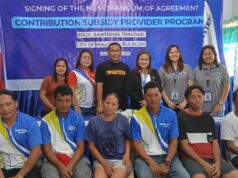“TEN THOUSAND years have passed since the current pleasantly temperate period began, so another sudden shift is overdue. The notion that greenhouse gases could trigger such a rapid change keeps serious scientists up at night…
And since scientists today have little understanding of past climate flips, it’s impossible to say when the next one will start.”
That was what Gregg Easterbrook noted in “A Skeptical Guide to Doomsday,” a 2003 Wired article. Climate change is, indeed, already here and everyone is affected. No one is spared from its wrath.
“Climate change isn’t something just for scientists, politicians, diplomats and academics,” wrote Richard Fuchs in his foreword for the book, Hotspots! Mapping Climate Change Vulnerability in Southeast Asia. “It’s an issue that people in communities in Southeast Asia already know about and sense is important on an everyday basis in their lives.”
And that include the indigenous peoples (IPs) group. The descendants of the original inhabitants, the IPs were not absorbed by centuries of Spanish and United States colonization of the Philippines archipelago, and in the process have retained their customs and traditions.
According to the National Commission for Indigenous Peoples (NCIP), the Philippines is a culturally diverse country with 110 ethnolinguistic groups. Of the country’s total population, 12% of them are IPs. “They are found in Northern Luzon, Mindanao, and with some groups in the Visayas,” informs Dr. Manuel S. Tan, Jr., the dean of the graduate school at the Cagayan State University.
As Cagayan Valley is home to 1,039,447, which represent 9% of the country’s total number of IPs. “There are 24 known IP groups in Region 2,” Dr. Tan said. “They rely on agriculture, fishery, and forestry for survival and livelihood.”
Like most Filipinos, they are vulnerable to the effects of climate change. This must be the reason why Dr. Tan conducted a study on the IPs of Cagayan Valley as to their climate change adaptation practices in agriculture, fisheries, and natural resources. “Our study covers 17 out of 24 IPs in the region,” Dr. Tan said.
“We wanted to document the IP’s knowledge, systems and practices relating to agriculture, fisheries and natural resources management under extreme weather condition like floods and droughts.”
Among the IPs included in the study were the Ivatans in Batanes; the Agtas, Applais, Ibatans, Itawes, and Malauegs in Cagayan; the Calingas, Ibanags Kankanaeys and Yogad in Isabela; and Ayangans, Bugkalots, Gaddangs, Ibalois, Isinais, I’waks, and Kalanguyas in Nueva Vizcaya.
The result of the study was presented by Dr. Tan himself during the Economics of Climate Change in Southeast Asia conference held in Siem Reap, Cambodia recently. It was convened by the Economy and Environmental Program for Southeast Asia.
The main finding of the study showed that most of the IP groups studied have resorted to commercial farming practices through the intensive use of commercial farm inputs. They do so to maximize their production while the weather is still fine.
“They are trying to build up a buffer stock in preparation for the coming droughts and floods,” said Dr. Tan. “In the process, however, they are not mitigating climate change but are making it worse.”
Of the 17 IPs surveyed, 11 groups relied “moderately to heavily” on farm mechanization and the usage of commercial farm inputs. Among primary crops, monocropping of either rice or corn predominates. Most farms yield 100-120 cavans of palay per hectare as a result of the high farm productivity. But Dr. Tan has discovered:
“All IP groups are receptive to environment friendly, climate change mitigating and adaptive agriculture if only there are organic farm inputs which can equal the efficacy of commercially prepared ones.”
In his study, Dr. Tan has identified several technologies which IP groups have been practicing that can help cushion the impact of climate change. For instance, instead of using commercial fi sh feeds, the Agtas of Sanchez Mira in Cagayan harvest termites and use them as feed for tilapias.
They also rely on the natural fertility of the soil in all their farming technologies. In addition, they don’t use commercial farm inputs like pesticides.
The Bugkalots of Dupax, Nueva Ecija uses herbal pesticides to drive away pests from their crops. Some elders have also found out that there are roots of some herbs that can equal the potency of Viagra.
The residents of Babuyan Claro harvest fish that they only need. In like manner, the products they produce from their farms are being consumed by the locals as they cannot sell them in the mainland due to long travel and distance.
There are also some beliefs of IPs that can be emulated by lowlanders. For instance, they believe in supernatural beings that guide them to have good harvest. In their rituals, they incorporate songs and dances before planting, while the crops are growing, and during harvesting.
The Ibalois of Nueva Vizcaya practice intercropping scheme. They plant vegetables along with rice and corn.
They use trees as windbreaks so as the crops are not blown away during strong winds. Being located in a typhoon-prone area, the Ivatans in Batanes plant root crops like sweet potato.
According to Dr. Tan, most IP groups follow what the researchers call as KISS (Keep It Simple and Sustainable).
“Living a simple life entails the emission of minimal carbon footprint,” said Dr. Tan. “They gather food enough only for eating,” Dr. Tan revealed.
“They rely on the forest for the rest of their needs. They do not use motorcars and instead they walk most of the time. They expend less energy thus burn less carbon. This is what you call as climate-friendly lifestyle.”




